The Jakobshavn glacier in Greenland retreated more than one foot per day from 1850 to 1903, while thinning by a “considerable extent.” It was also reported that alpine glaciers were in general retreat, and “conclusively that the glaciers of Greenland are receding”
Government climate experts say that the period of ice loss from 1850 to 1910 experienced global cooling, and was the coldest on record.
In 1908, National Geographic reported that Alaskan glaciers at Glacier Bay retreated eleven feet per day from 1894 to 1907, during the coldest years on record.
USGS reports that Glacier Bay glaciers retreated four feet per day from 1760 to 1907. I annotated the map to show which periods of melting are considered natural by scientists, and which periods are caused by man.
In 1910, it was reported that the glaciers of the world had been retreating since at least 1836.
In 1911, it was reported that glaciers in the Alps were disappearing.
In 1902, it was reported that glaciers in the Alps were retreating more than 100 feet per year.
In 1932 it was reported that the glaciers of west Antarctica had been rapidly retreating for at least a century.
Government climate experts claim that glacial retreat is due to global warming, yet their own fraudulent temperature data demonstrates that they are wrong.


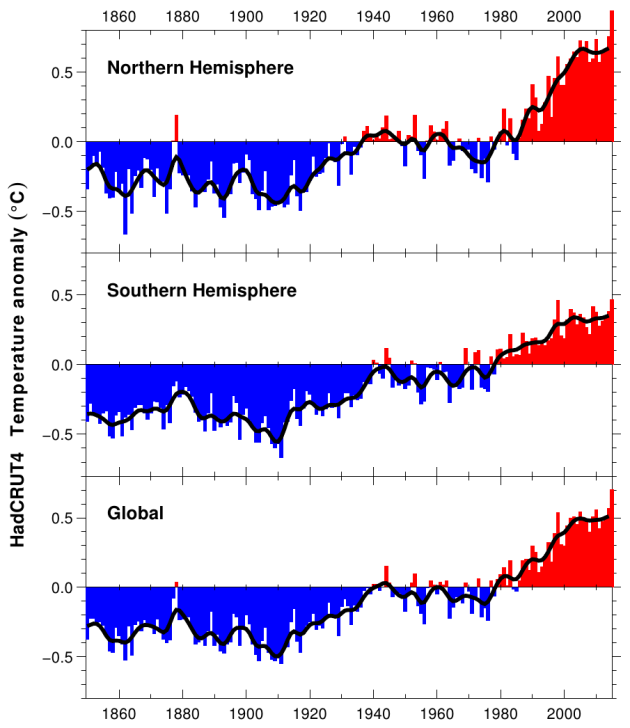
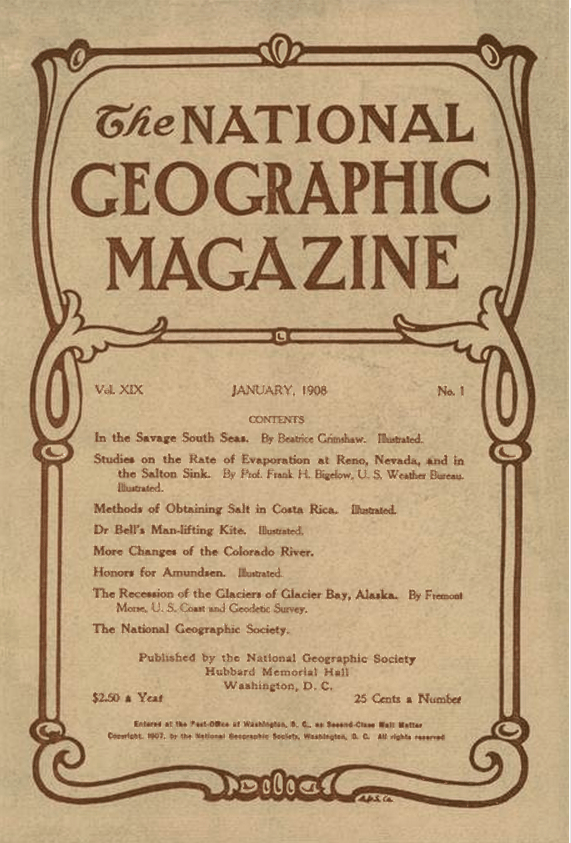

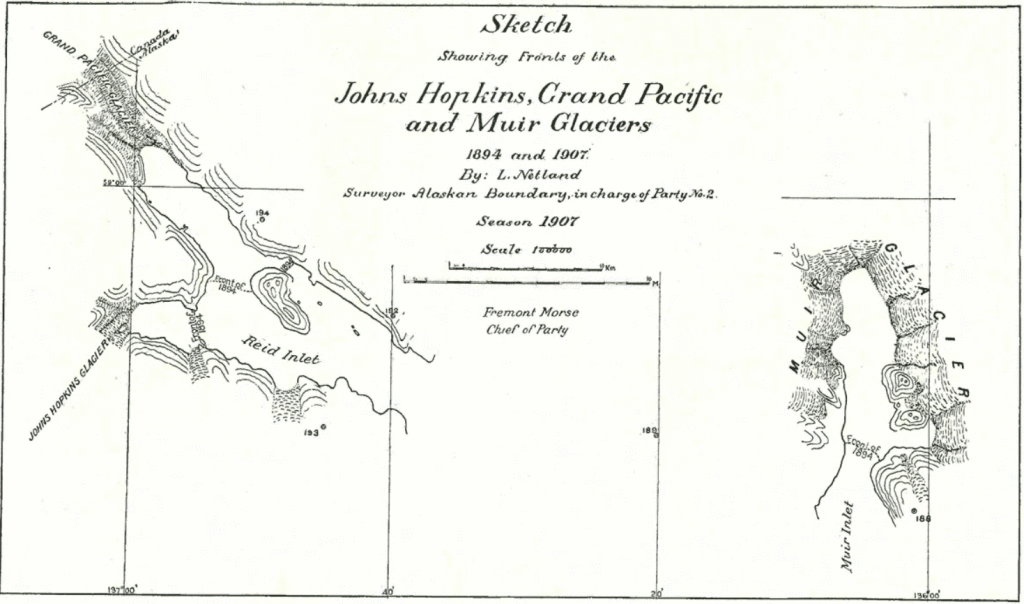
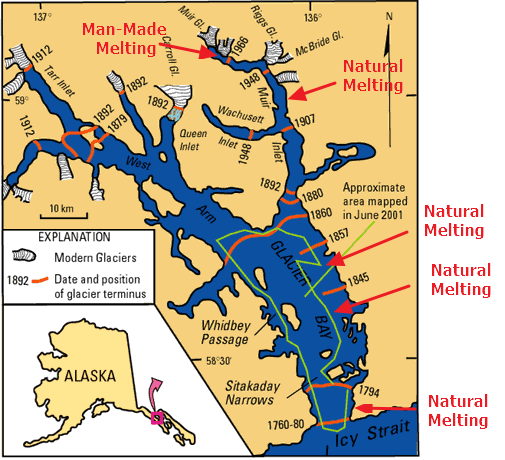

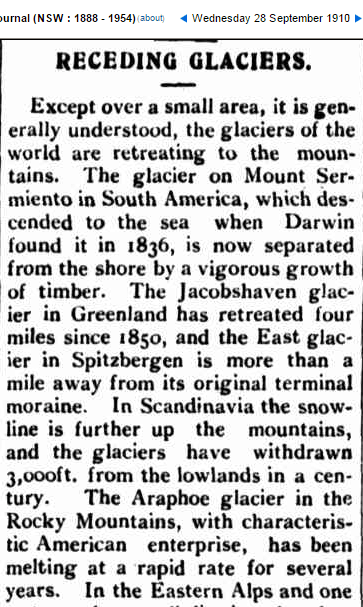
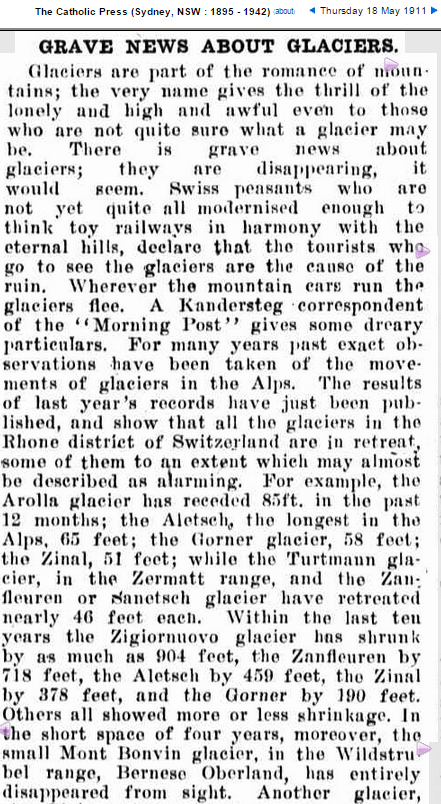



The exit from the Little Ice Age was abrupt, occurring in a decade around 1850 when the climate shifted to present day warmth.
Temperature and precipitation history of the Arctic
Miller et al
Institute of Arctic and Alpine Research and Department of Geological Sciences, University of Colorado, USA et al
At paper looking at glaciers in Norway.
A new approach for reconstructing glacier variability based on lake sediments recording input from more than one glacier
January 2012
Kristian Vasskoga Øyvind Paaschec, Atle Nesjea, John F. Boyled, H.J.B. Birks
A video from the guys actually at the ice face..
You know REAL SCIENTISTS !!!
https://vimeo.com/14366077
That guy in your Video must not want to get another grant.
No idea who funds the Niels Bohr Institute, but obviously NOT the alarmist bletheren. !!
This guy and his group are real scientists….
and that is something that most climate modellers and theoreticians WILL NEVER BE.
Government Climate Experts are liars.
A Class Action charging scientific fraud that has directly resulted in the increase of nefarious taxes and energy prices that materially cost money to the plaintiffs (i.e. all people who pay their energy bills and their taxes) should be raised against the said “Government Climate Experts” individually and collectively.
In Australia, I would sign up to that.
http://www.climate4you.com/ClimateAndHistory%201900-1949.htm#1939-1940:%20The%20Finish-USSR%20winter%20war%C2%A0
Year 1900-1949 AD
List of contents
•1900: Beginning doubts about the climatic importance of CO2
•1909-1917: Difficult sea ice conditions around Spitsbergen
•1911: Niagara Falls frozen
•1912: The loss of the Titanic
•1917: The coalmine Sveagruvan opens in Spitsbergen, Svalbard
•1919-1925: Improving sea ice conditions around Spitsbergen
•1922: The changing Arctic; warming in Spitsbergen
•1923: Establishment of early meteorological stations in the Soviet Arctic
•1929: Establishment of the Unified Hydrological and Meteorological Bureau of the USSR
•1930: Birkeland draws attention to Arctic warming
•1931: Victor Franz Hess initiates measurements of cosmic rays at Hafelekar, Austria
•1932: First navigation of the Northeast Passage without wintering
•1933: Stalin orders the Northeast Passage made a navigable waterway
•1934: The worst weather in the world
•1938: Vernagtferner in Austria retreats
•1939-1940: The Finish-USSR winter war
•1939-1940: The cold winter postpones the German attack on France
•1940: Russian icebreaker Sedow ends its drift across the Arctic Ocean
•1940: Long sailing season and occasionally no winter ice on fjords in western Spitsbergen
•1940: German Hilfskreuzer Komet navigates the Northeast Passage en route to the Pacific Ocean
•1940: The Northeast Passage reported ice free from late August to late September
•1941: February: German battleship Bismarck stuck in Hamburg because of sea ice
•1941: May: Circumnavigating a storm centre; Bismarck’s sortie into the North Atlantic
•1941: Operation Barbarossa, the German invasion of USSR
•1942: Second ship to navigate the Northwest Passage
•1942: U-435 evacuates Wettertrup “Knospe”
•1942: Operation Wunderland
•1942: Jakobshavn Isbræ in West Greenland retreats
•1942-1943: Stalingrad, a turning point of the 2nd World War
•1943: The Walter submarine
•1944: D-Day in West Europe
•1944: Worst June storm in 40 years destroys Allied harbours in Normandy
•1947: Retreat of outletglaciers from Jostedalsbreen in southern Norway
•1949: Recent climatic fluctuations by Leo Lysgaard
•Back to Climate and History main menu
?
An interesting book describing the melting of the Arctic and a lot of science by N.N.Zubov this page describes the melting. http://www.archive.org/stream/arcticice00zubo#page/470/mode/2up